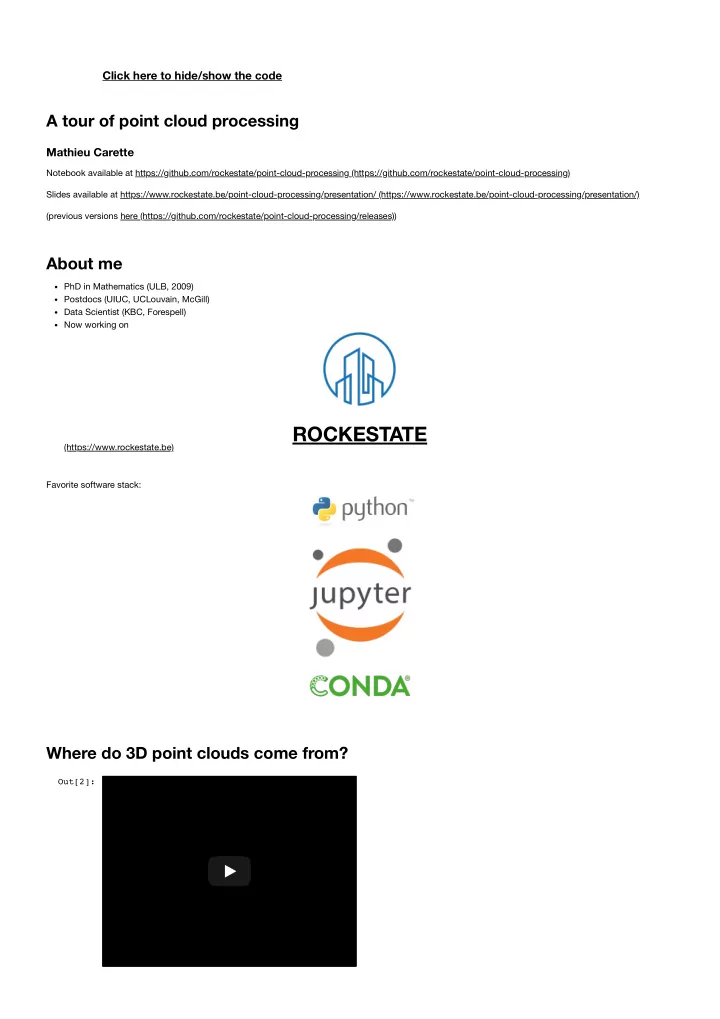

Click here to hide/show the code A tour of point cloud processing Mathieu Carette Notebook available at https://github.com/rockestate/point-cloud-processing (https://github.com/rockestate/point-cloud-processing) Slides available at https://www.rockestate.be/point-cloud-processing/presentation/ (https://www.rockestate.be/point-cloud-processing/presentation/) (previous versions here (https://github.com/rockestate/point-cloud-processing/releases)) About me PhD in Mathematics (ULB, 2009) Postdocs (UIUC, UCLouvain, McGill) Data Scientist (KBC, Forespell) Now working on ROCKESTATE (https://www.rockestate.be) Favorite software stack: Where do 3D point clouds come from? Out[2]: Terrapoint Aerial Services - LiDAR Flight Sim…
Open LiDAR data for Brussels and Flanders : https://remotesensing.agiv.be/opendata/lidar/ (https://remotesensing.agiv.be/opendata/lidar/) File formats and software LAS (https://www.asprs.org/committee-general/laser-las-file-format-exchange-activities.html) standard file format LAZ (https://www.laszip.org/) compressed file format PCL (http://pointclouds.org/) P oint C loud L ibrary Open source: https://github.com/PointCloudLibrary/pcl (https://github.com/PointCloudLibrary/pcl) C++ Powerful general purpose algorithms CGAL (https://www.cgal.org/) C omputational G eometry A lgorithms L ibrary Open source: https://github.com/CGAL/cgal (https://github.com/CGAL/cgal) C++ State of the art 2D and 3D geometry algorithms PDAL (https://www.pdal.io) P oint D ata A bstraction L ibrary Open source: https://github.com/PDAL/PDAL (https://github.com/PDAL/PDAL) C++, command-line, python Wraps some PCL functionality For windows users: part of the OSGeo4W (https://trac.osgeo.org/osgeo4w/) distribution LAStools (https://rapidlasso.com/lastools/) from RapidLasso Proprietary, preferred pricing for academic use Windows only, runs on wine command-line, GUI Open source laszip (https://www.laszip.org) compression/decompression: https://github.com/LASzip/LASzip (https://github.com/LASzip/LASzip) Let's process some point clouds
Selecting street portion with a polygon POLYGON ((150687.8518289287 167058.3858805448, 150939.3740217351 167072.33228858, 150980.4548986266 16674 3.7380920332, 150919.5663185167 166714.6929215267, 150754.0807228128 166712.885090881, 150581.449810213 1 66933.4497666787, 150687.8518289287 167058.3858805448)) CPU times: user 15.9 s, sys: 318 ms, total: 16.2 s Wall time: 16.3 s Pipeline selected 473184 points (4.4 pts/m2)
Original data
Use gound / non-ground classification Use point flatness to separate trees from the rest
Find treetops as local maxima Separate trees using closest treetop
Model each tree individually Final street model Building Modeling
Selecting building with a polygon POLYGON ((150876.6899425487 166855.1808815384, 150913.4053620266 166873.7645316971, 150904.3812825281 166 890.1151175071, 150861.390885691 166886.3253158694, 150876.6899425487 166855.1808815384)) CPU times: user 5.39 s, sys: 880 ms, total: 6.27 s Wall time: 6.5 s Pipeline selected 31223 points (28.8 pts/m2) Original data
Visualize normals Infer building orientation using normals
Align building orientation along X-Y axes Model the building using axis-aligned view
Rotate back to original coordinate system Add texture from aerial imagery Things to look out for pdal Fast point-in-polygon algorithm implemented Apache arrow support Conda packaging
jupyter C++ jupyter kernels Jupyterlab Thank you!
Recommend
More recommend